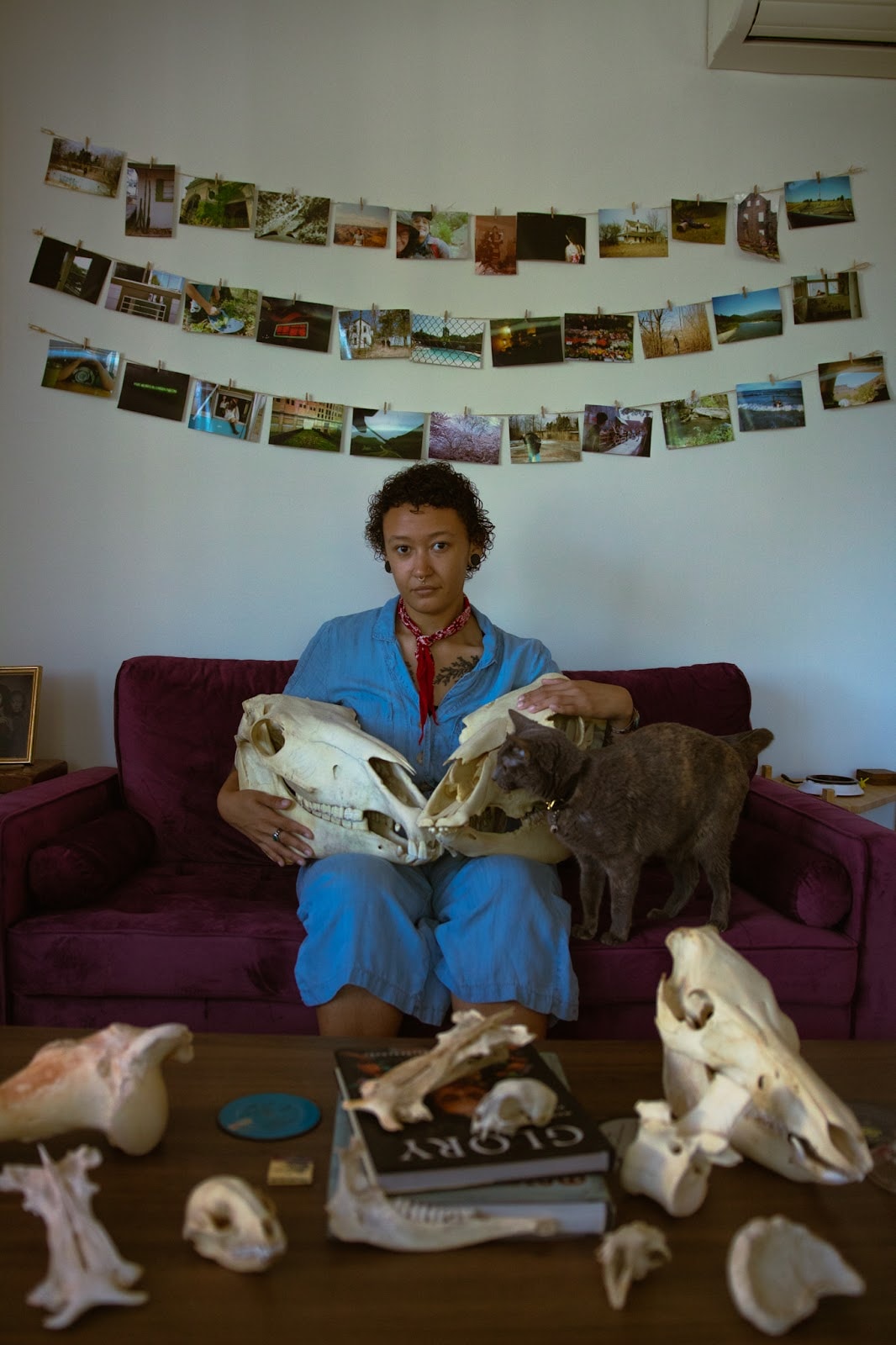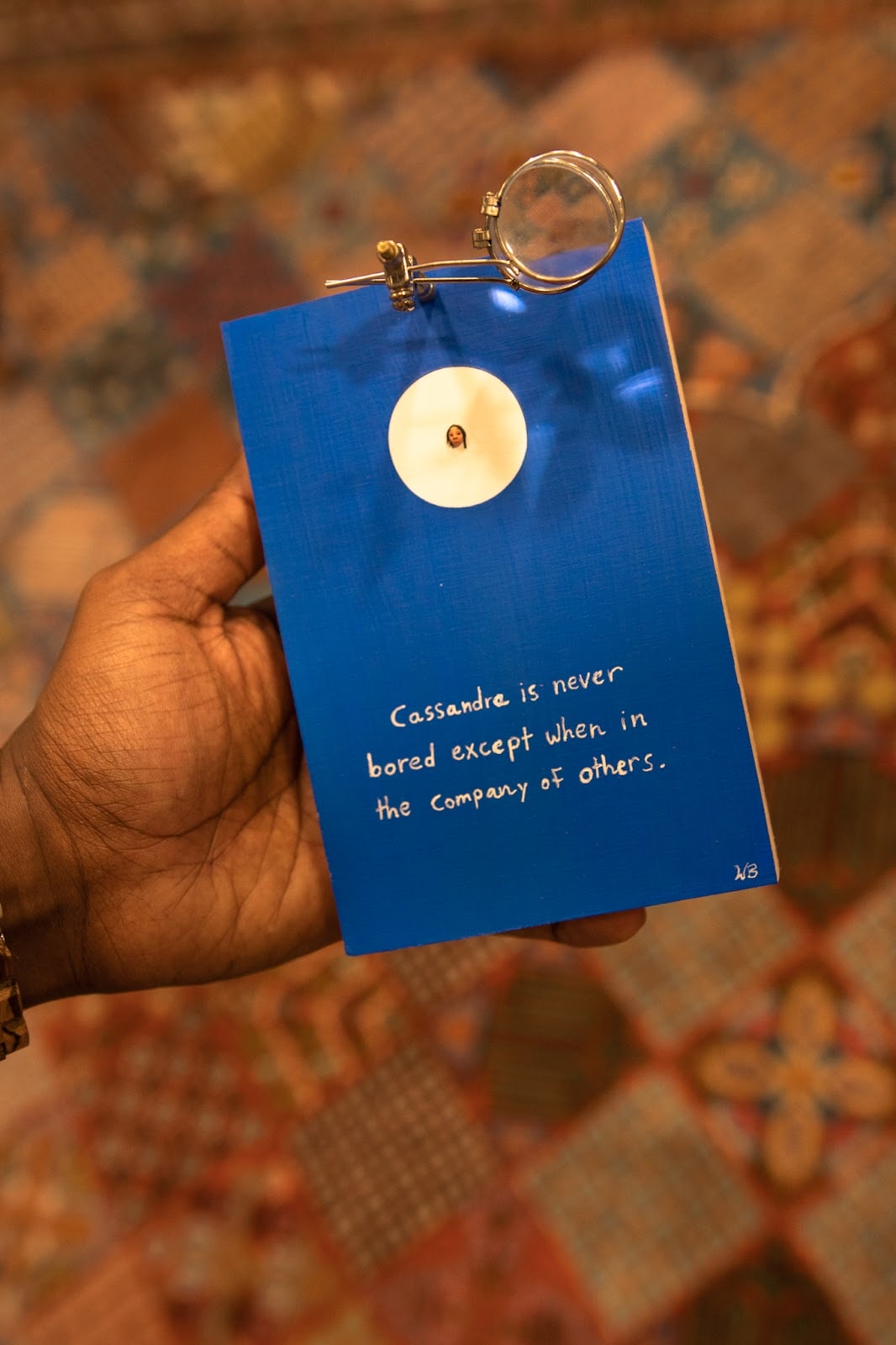Local LGBTQ Artists Discuss Embracing Their Authentic Selves Free to 'Just Be'
Published July 1st, 2022 at 12:50 PM
Above image credit: Vy Nguyen's written explanation of her work as part of a photo gallery of local LGBTQ artists, (Ji Stribling | Flatland)In this photo series, Flatland was invited into the studios of seven different artists, ages 18 to 40. There, we were able to delve into their creative spaces and learn about how their work connects them to the
LGBTQIA+ community.
The following digital galleries, photographed by Flatland’s Ji Stribling, are explained in the artists’ own words.
Vy Nguyen, 18



Hi, my name is Vy Nguyen. I’m an 18-year-old Vietnamese-American artist who identifies as bisexual. Film not only serves as a way to express my personal feelings and identities, but it also serves as a way to tell the stories of other people through it— and especially, stories that may be less common. I made my first LGBTQ+ film titled “Woman” during November 2020 about a trans woman and the anxiety she felt as she prepared for her blind date. That film became a catalyst for the themes surrounding my future projects. I realized I wanted to produce works that made people feel something, whether it was laughter or tears, I wanted them to feel it all. Creating that film also prompted me to explore my identities— both the struggles and why I’m proud to identify as certain identities. Even another work I’ve made, “The Box We Bring” (April 2021), alludes to a queer relationship despite it not being the central theme.
Bella Grace Cordero, 20



A lot of my work revolves around topics of sex. As a queer artist, I found peace by processing trauma through photography and filmmaking. Art has allowed me to understand myself as an artist and my sexuality.
Halla, 23



Cooking is something I shut away for a very long time. It was something I used to do with my family, and as I got older, that relationship got weaker; and in turn, so did my relationship with cooking. I came out a little over two years ago, and within that time, I began picking up jobs in kitchens. The more I was there, the more my creative flow began to come out. For a while, I felt nothing — as if I had no purpose. It wasn’t until my first fine dining experience that I began to realize food is where my heart and soul lie. And the more I let it out, the more I let myself out, and the more free I feel to just be. Cooking helps me express myself in ways I haven’t found before. It’s a constant challenge, but also my comfort zone. Also, I just LOVE food! I’m no chef, but I can definitely say I hope to own that title one day.
Mak Allen, 27



As a child, I was always referred to as “boyish” and a “tomboy,” as I preferred more hands-on, dirtier, outdoorsy activities. My interests then were somewhat obscure. The first things I vividly remember obsessing over were bog mummies, the supernatural phenomena of ghosts and spirits, and the cycle of life and death (specifically reincarnation). From a very early age — like even as an infant — I was venturing off on my own into the woods, to ponds, lakes, and creeks, out into the fields off to find hidden treasures, from old barns to old rocks to old bones. I was fascinated by the macabre, yet sobering, fragility of life and was really awed by it. I think these interests followed me into adulthood as much as my queerness did: from a queer, peculiar tot to a queer, confident adult. Queerness used to be like an “othering” part of myself that made people uncomfortable, or uneasy. I think my art can make a lot of people feel that way, but once I started to pick apart the stigmas and taboos of these parts of myself, I found that they were all the parts that made the most sense to me and that I liked the best. I really found my community in the world when I put aside all my fears of judgment or sneers — both about how I live my life, and what I do in it.
Tanith K, 34



My name is Tanith K. I’m a 34-year-old nonbinary/trans bi-con currently living in Kansas City. I didn’t fully understand my relationship with queerness until my late twenties. I was in denial about my bisexuality for several long years, wrapped up tight in internalized homo- and bi-phobias commonplace during the ’90s. Never mind the complicated gender relationship on top of all of that! It wasn’t until I was 27, when a friend of mine at the time about 20 years older than me started to go through their own gender journey. I had never even thought that being trans was an option up until that point and having a nonbinary identity wasn’t even on the radar. Sharing their story with me changed my perspective on so many things. I came out two years later at 29.
A big chunk of my art revolves around my relationship with my sexuality and gender identities. I reflect on how I can be both hyper visible and deliberately invisible to so many people. It’s complex, filled to the brim with contradictions, known and unknown. I aim to capture the struggle and joy of living authentically with nuance in a world that demands manufactured authenticity and one-dimensionality.
Wolfe Brack, 39



I identify as a Black cis gay man. I don’t often deal with my queerness directly in my art, but I feel it lends a more inclusive perspective in my curation practice. Being a part of two intersecting minority communities compels me to look for opportunities to center underrepresented artists and experiences. I also work with Electrosexual, a group of queer creatives that hosts safe, inclusive LGBTQ+ parties in the area.
Hugo Ximello-Salido, 40



I am a Mexican-born artist that finds inspiration in the traditions and colors of Mexican culture. My work explores the intersection of culture, language, and personal experience without losing sight of universal human themes. Through art, he hopes to stimulate a kind of fascination in the viewer to stimulate a kind of fascination in the viewer that transforms the imagination with a sense of beauty.
As a native Mexican, culture and tradition are a vital part of my heritage. As a Mexican-American, I am fascinated by the dialogue between different cultures and traditions. As an artist, I explore personal experiences, emotions, and connections through the lens of my past and present in order to create a vibrant future. Through my work, I strive to increase social awareness of the many parts of my intersectional identity and experience as a Mexican-American member of the LGBTQ community.
My early work focuses on the legacy of Mexican culture and its collision with the American experience. Major inspirations include Mexican colonial style, “La Catrina” (the elegant skull), and other culturally significant symbols such as La Loteria Mexicana (Mexican bingo), papel picado (perforated tissue paper), and Talavera. I use a variety of materials, including acrylic paint, ink, gels, sand, papier-mâché, spray paint, and more to modernize, revive, and reinvent the Mexican art that inspires me.
Through each piece, I seek to convey a unique yet universal sense of being, feeling, or thought. I hope to challenge stereotypes, commercialization and commodification, and the arbitrary barriers we create between our shared humanity. My point of view emerges from varied perspectives on language, cultural differences, race, cultural bias, and more. My process is meditative and expressive, an expulsion of demons and a dispensation of beauty.
By crafting original artworks inspired by Mexican folklore, diverse communities, and daily experiences, I endeavor to bridge the gap between past and present as a modern, Mexican-American artist.
Ji Stribling is a student at the University of Missouri-Kansas City and a reporting intern at Kansas City PBS.


